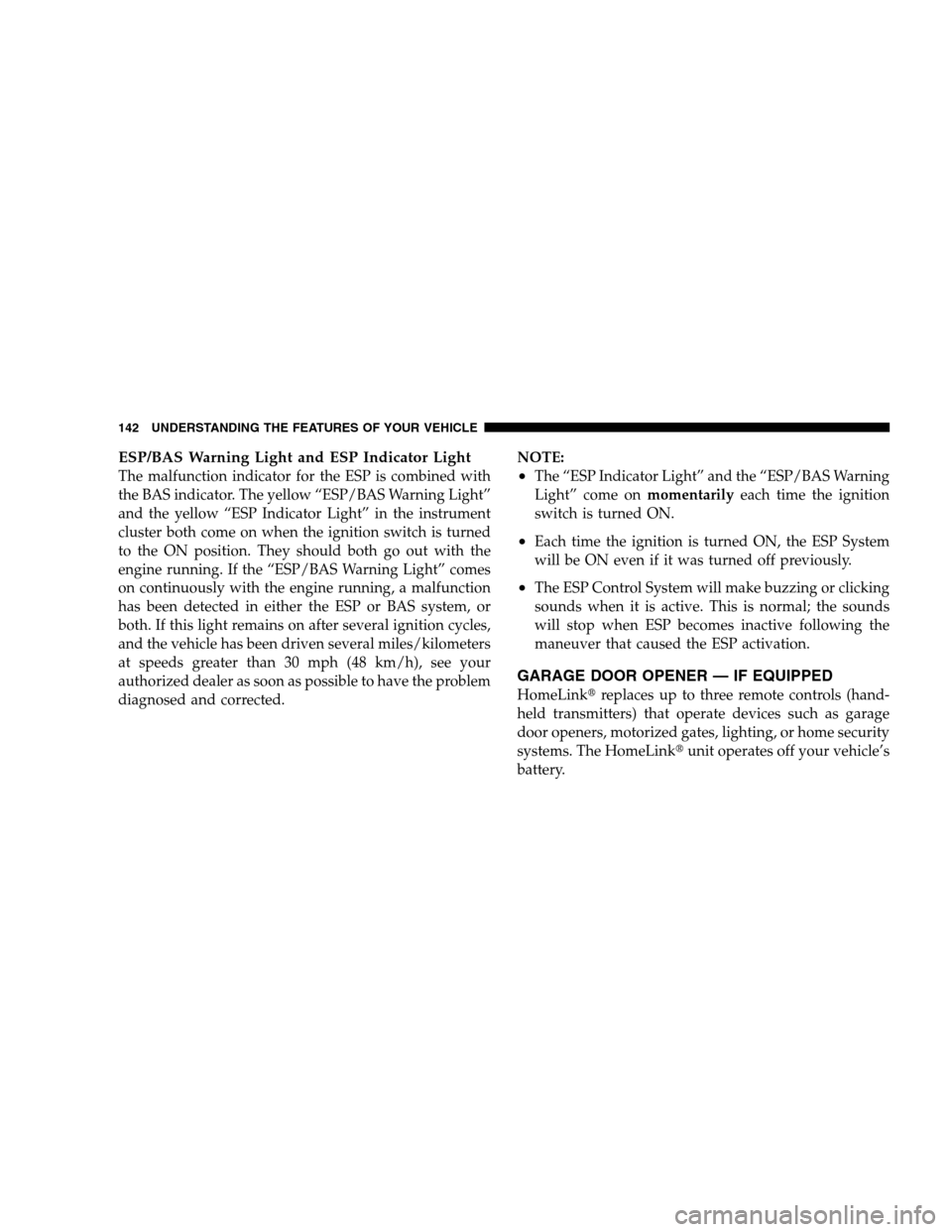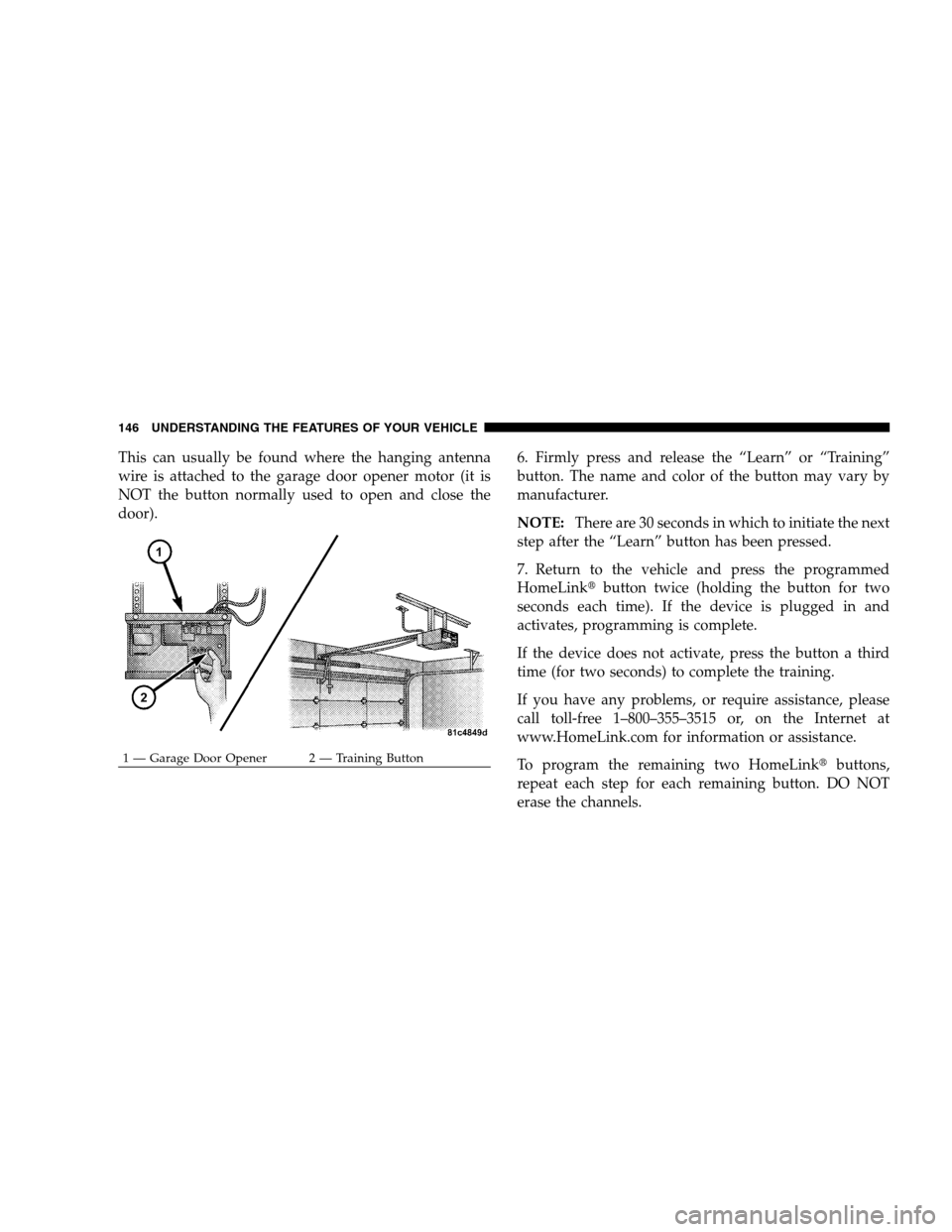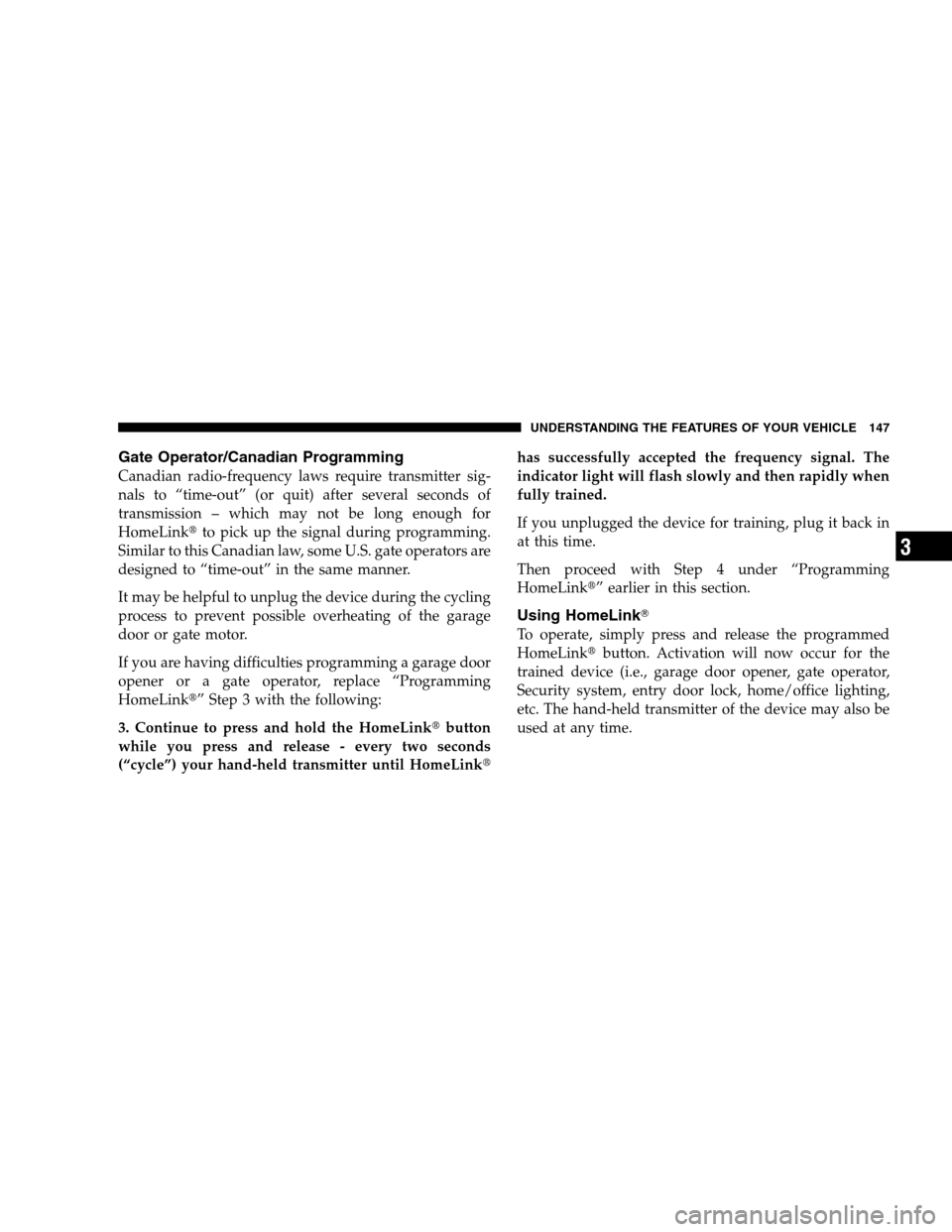Page 77 of 438

�Windshield Wipers And Washers...........127
▫Windshield Wiper Operation.............127
▫Intermittent Wiper System...............128
▫Windshield Washers...................128
▫Mist Feature.........................129
�Tilt Steering Column....................130
�Electronic Speed Control — If Equipped......130
▫To Activate..........................131
▫To Set At A Desired Speed...............131
▫To Deactivate........................132
▫To Resume Speed.....................132
▫To Vary The Speed Setting...............132
▫Manual Transaxle.....................132▫To Accelerate For Passing...............133
�Anti-Lock Brake System (ABS) —
If Equipped...........................133
�Electronic Brake Control System............134
▫Anti-Lock Brake System (ABS)............134
▫Brake Assist System (BAS)...............135
▫Traction Control System (TCS)............136
▫Electronic Roll Mitigation (ERM)..........136
▫Hill Descent Control (HDC) — If Equipped . . . 137
▫Electronic Stability Program (ESP).........138
�Garage Door Opener — If Equipped.........142
▫Programming HomeLink�...............144
▫Gate Operator/Canadian Programming.....147
UNDERSTANDING THE FEATURES OF YOUR VEHICLE 75
3
Page 78 of 438

▫Using HomeLink�.....................147
▫Reprogramming A Single
HomeLink�Button....................148
▫Security............................148
▫Troubleshooting Tips...................148
▫General Information...................149
�Power Sunroof — If Equipped.............149
▫Opening The Sunroof..................150
▫Closing The Sunroof...................150
▫Pinch Protect Feature...................151
▫Pinch Protect Override.................151
▫Venting Sunroof — Express..............151
▫Sunshade Operation...................152▫Wind Buffeting.......................152
▫Sunroof Maintenance...................152
▫Ignition Off Operation..................152
�Electrical Power Outlets — If Equipped.......152
▫Electrical Outlet Use With Engine Off.......154
�Console Features.......................155
�Cargo Area Features.....................156
▫Cargo Light/Removable Self Recharging
Flashlight — If Equipped................156
▫Retractable Cargo Area Cover —
If Equipped.........................158
▫Removable Load Floor..................159
▫Cargo Tie-Down Loops.................160
▫Fold Down Speakers — If Equipped........161
76 UNDERSTANDING THE FEATURES OF YOUR VEHICLE
Page 144 of 438

ESP/BAS Warning Light and ESP Indicator Light
The malfunction indicator for the ESP is combined with
the BAS indicator. The yellow “ESP/BAS Warning Light”
and the yellow “ESP Indicator Light” in the instrument
cluster both come on when the ignition switch is turned
to the ON position. They should both go out with the
engine running. If the “ESP/BAS Warning Light” comes
on continuously with the engine running, a malfunction
has been detected in either the ESP or BAS system, or
both. If this light remains on after several ignition cycles,
and the vehicle has been driven several miles/kilometers
at speeds greater than 30 mph (48 km/h), see your
authorized dealer as soon as possible to have the problem
diagnosed and corrected.NOTE:•The “ESP Indicator Light” and the “ESP/BAS Warning
Light” come onmomentarilyeach time the ignition
switch is turned ON.
•Each time the ignition is turned ON, the ESP System
will be ON even if it was turned off previously.
•The ESP Control System will make buzzing or clicking
sounds when it is active. This is normal; the sounds
will stop when ESP becomes inactive following the
maneuver that caused the ESP activation.
GARAGE DOOR OPENER — IF EQUIPPED
HomeLink�replaces up to three remote controls (hand-
held transmitters) that operate devices such as garage
door openers, motorized gates, lighting, or home security
systems. The HomeLink�unit operates off your vehicle’s
battery.
142 UNDERSTANDING THE FEATURES OF YOUR VEHICLE
Page 145 of 438
The HomeLink�buttons that are located in the head liner
or the sun visor designate the three different HomeLink�
channels.
NOTE:HomeLink�is disabled when the Vehicle Secu-
rity Alarm is active.WARNING!
Your motorized door or gate will open and close
while you are training the Universal Transceiver. Do
not train the transceiver if people or pets are in the
path of the door or gate. Only use this transceiver
with a garage door opener that has a “stop and
reverse” feature as required by Federal safety stan-
dards. This includes most garage door opener models
manufactured after 1982. Do not use a garage door
opener without these safety features. Call toll-free
1–800–355–3515 or, on the Internet at
www.HomeLink.com for safety information or
assistance.
HomeLink�Buttons
UNDERSTANDING THE FEATURES OF YOUR VEHICLE 143
3
Page 146 of 438

WARNING!
Vehicle exhaust contains carbon monoxide, a danger-
ous gas. Do not run your vehicle in the garage while
training the transceiver. Exhaust gas can cause seri-
ous injury or death.
Programming HomeLink�
Before You Begin
If you have not trained any of the HomeLink�buttons,
erase all channels before you begin training.
To do this, press and hold the two outside buttons for 20
seconds until the red indicator flashes.
It is recommended that a new battery be placed in the
hand-held transmitter of the device being programmedto HomeLink�for more efficient training and accurate
transmission of the radio-frequency signal.
Your vehicle should be parked outside of the garage
when programming.
1. Turn the ignition switch to the ON/RUN position.
2. Hold the battery side of the hand-held transmitter
away from the HomeLink�button you wish to program.
Place the hand-held transmitter 1–3 in (3-8 cm) away
from the HomeLink�button you wish to program while
keeping the indicator light in view.
3. Simultaneously press and hold both the chosen
HomeLink�button and the hand-held transmitter button
until the HomeLink�indicator changes from a slow to a
rapidly blinking light, then release both the HomeLink�
and hand-held transmitter buttons.
144 UNDERSTANDING THE FEATURES OF YOUR VEHICLE
Page 147 of 438

Watch for the HomeLink�indicator to change flash rates.
When it changes, it is programmed. It may take up to 30
seconds, or longer in rare cases. The garage door may
open and close while you train.
NOTE:
•Some gate operators and garage door openers may
require you to replace Step 3 with procedures noted in
the “Gate Operator/Canadian Programming” section.
•After training a HomeLink�channel, if the garage
door does not operate with HomeLink�and the ga-
rage door opener was manufactured after 1995, the
garage door opener may have a rolling code. If so,
proceed to the heading “Programming A Rolling Code
System.”4. Press and hold the just-trained HomeLink�button
and observe the indicator light.
If the indicator light stays on constantly, programming is
complete and the garage door (or device) should activate
when the HomeLink�button is pressed.
If the indicator light blinks rapidly for two seconds, and
then turns to a constant light, continue with program-
ming for a Rolling Code.
5. PROGRAMMING A ROLLING CODE SYSTEM
At the garage door opener motor (in the garage), locate
the “Learn” or “Training” button.
UNDERSTANDING THE FEATURES OF YOUR VEHICLE 145
3
Page 148 of 438

This can usually be found where the hanging antenna
wire is attached to the garage door opener motor (it is
NOT the button normally used to open and close the
door).6. Firmly press and release the “Learn” or “Training”
button. The name and color of the button may vary by
manufacturer.
NOTE:There are 30 seconds in which to initiate the next
step after the “Learn” button has been pressed.
7. Return to the vehicle and press the programmed
HomeLink�button twice (holding the button for two
seconds each time). If the device is plugged in and
activates, programming is complete.
If the device does not activate, press the button a third
time (for two seconds) to complete the training.
If you have any problems, or require assistance, please
call toll-free 1–800–355–3515 or, on the Internet at
www.HomeLink.com for information or assistance.
To program the remaining two HomeLink�buttons,
repeat each step for each remaining button. DO NOT
erase the channels.
1 — Garage Door Opener 2 — Training Button 146 UNDERSTANDING THE FEATURES OF YOUR VEHICLE
Page 149 of 438

Gate Operator/Canadian Programming
Canadian radio-frequency laws require transmitter sig-
nals to “time-out” (or quit) after several seconds of
transmission – which may not be long enough for
HomeLink�to pick up the signal during programming.
Similar to this Canadian law, some U.S. gate operators are
designed to “time-out” in the same manner.
It may be helpful to unplug the device during the cycling
process to prevent possible overheating of the garage
door or gate motor.
If you are having difficulties programming a garage door
opener or a gate operator, replace “Programming
HomeLink�” Step 3 with the following:
3. Continue to press and hold the HomeLink�button
while you press and release - every two seconds
(“cycle”) your hand-held transmitter until HomeLink�has successfully accepted the frequency signal. The
indicator light will flash slowly and then rapidly when
fully trained.
If you unplugged the device for training, plug it back in
at this time.
Then proceed with Step 4 under “Programming
HomeLink�” earlier in this section.
Using HomeLink�
To operate, simply press and release the programmed
HomeLink�button. Activation will now occur for the
trained device (i.e., garage door opener, gate operator,
Security system, entry door lock, home/office lighting,
etc. The hand-held transmitter of the device may also be
used at any time.
UNDERSTANDING THE FEATURES OF YOUR VEHICLE 147
3